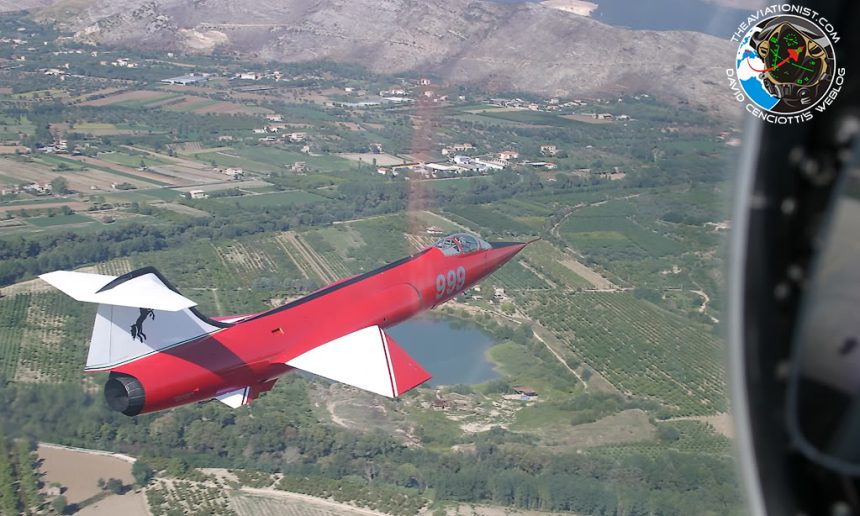There are basically 2 ways to rejoin a chasing aircraft with another aircraft of a different type: the interception and the so-called “airborne pickup”. Since I’m talking about dissimilar aircraft, I’m not considering the formation take-off, something that is performed by two aircraft of the same type.
Interception of an aircraft is something mostly related to the use of on-board radar (when available) or to the guidance of an “external” radar (i.e. phisically located elsewhere, typically, an Air Defense radar providing Ground Controlled Interception, or an AWACS, providing Airborne Early Warning and fighter control to the fighters, by means of radio communication or data-link).
However, it can be achieved even without radar, by pinpointing the target knowing its altitude, speed and relative position (in terms of radial and distance) to a radio-aid or well-known point. This procedure is useful when aircraft involved are already flying or if they have to rejoin in a particular airspace departing from different airfields and/or at different times.
With an MB.339 taken off from Grazzanise and piloted by Col. Gianpaolo Miniscalco, I intercepted a flight of 4 F-104s, c/s “Picca 11” that had departed from the same base 30 minutes before us. They had executed some training activities inside R-50 area (in Central Italy) and were returning to base.
“Picca 11” was not coming home as a single flight but had split into two sections: “number 1” was a single clean Starfighter heading back first due to fuel while “second section”, 5 minutes behind, was composed by 3 aircraft in a tip configuration. Since we were flying VFR an aicraft not equipped with radar, we had to rely on radio-comms to get on the returning F-104s in time to get some pictures.
Both us and the first F-104 were already flying in the same airspace, the R-62, a wide area restricted to military flights located above the Gulf of Gaeta, a few miles to the West North West of Grazzanise airbase. In order to keep vertical separation we flew at 8.000 ft, 1.000 above the F104.
We were still more than 10 miles away and couldn’t acquire visual contact with our “target” because, despite the characteristic smokey J-79 engine, a clean F-104 is almost invisible against a scattered sky. Miniscalco contiguously compared our position to the one provided by Lt. Maiorino (the pilot of the number 1) on the radio and, in a matter of minutes, we got visual with the Starfighter. For the rejoin with the 3 F-104 we swapped the roles: we did the target and the “second section” used a fix-to-fix navigation to intercept us.
When aircraft of dissimilar type depart from the same base and need to rejoin as soon as possible, another kind of procedure is often performed: the airborne pickup.
Typical scenarios are the rejoin after takeoff of a tanker with the receivers flying as a single flight or of a prototype with a chase aircraft during a test flight. Airborne pickup starts with aircraft departing from the same airbase.
Let’s explain it in a typical scenario: a mission composed by two aircraft, a leader (for ex. an AMX) and a chase (an MB.339).
The two aircraft taxi together but the chase lines up and takes off first (after receiving clearance to perform the procedure).
Immediately after departure, the MB.339, makes a 180 turn back towards the tarmac and enters the downwind leg for the runway in use. “30 seconds!” is the radio call of the chase pilot to time his approach to the runway to the leader’s take-off.
While the MB.339 is in the second base turn to head back to the runway, the AMX eases its brakes to start the take-off roll.
If everything goes on as planned, the MB.339 should be flying in formation with the leader as soon as the AMX has completed the departure and before it starts the next turn inbound the first waypoint.
I was on the backseat of the MB.339 when Capt. Maurizio performed this kind of procedure to rejoin with the AMX of the 311th Gruppo flown by Capt. Locatelli at the beginning of an air-to-air photo session with the RSV (Reparto Sperimentale Volo).
The procedure was perfectly executed and we were on the right wing of the AMX in time, just before it started a left turn inbound the sea but, obviously, things can be more difficult if aircraft involved have much different take-off performances.
Just think about rejoining an MB.339 with an F-104 taking off with full afterburner in clean configuration. Perfect calculations and quick corrections (if needed), are paramount to succeed in this procedure, performed visually even if flying under IFR rules.
On Sept. 19 2003, I flew an airborne pickup with Col. Miniscalco (with an MB.339 carrying tip + pylon tanks) in order to rejoin with the F-104 MM6930 on the day of the roll-out of the 9-99. We correctly rejoined with the “Picca 01” flown by Lt. Col. Strozza, but G-forces involved were higher since we were compelled to cut the final turn to catch up with the clean Starfighter.








